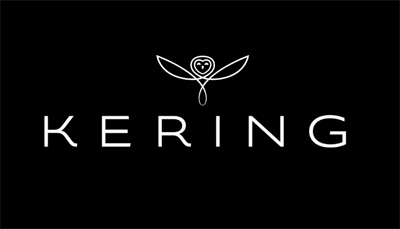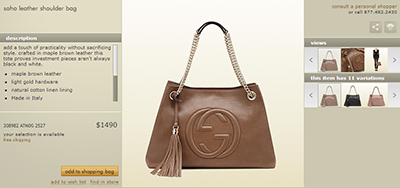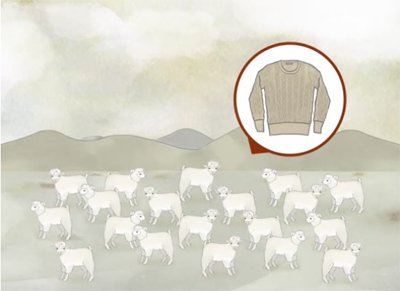On average, the supply chain accounts for half of the typical corporation’s carbon emissions, according to a report by French luxury conglomerate Kering and non-profit consultancy BSR.
Climate change could have negative effects on the quality and availability of a number of raw materials, and the associated combative measures could also impact the fashion industry. To assure their own futures, brands in fashion must play a part in reducing emissions and combating climate change, building it into their long-term strategy.
"Every company should be redefining itself as sustainable, not just luxury companies," said Marie-Claire Daveu, chief sustainability officer and head of international institutional affairs at Kering. "It's part of doing business in today's world when risks such as climate change are already a reality and predicted to only increase. Some of the most precious materials are essential for luxury and central to the luxury value proposition.
"As such, luxury has a particular responsibility to make sure these materials are produced in a sustainable and responsible manner, she said. "We are also a part of the broader apparel sector which needs to show the way forward for new business models and approaches that can ensure sustainable materials. This includes recycling and closed loop, innovation around new materials and also around the way we produce the more traditional raw materials.
"However, there is no single solution and we have to integrate a suite of solutions for the complex challenges we are facing. Our report shows that there is already an impact of climate change on the supply chains and we all need to act now because the future business of our sector depends on it."
“Climate Change: Implications and Strategies for the Luxury Fashion Sector” uses findings from numerous studies to determine the impact climate change is having and will continue to have on the fashion industry. Issues such as transportation and delivery disruption and resource scarcity, as well as the challenges associated with social change.
Getting hot in here
Cashmere, leather, vicuña, silk and cotton are all having availability and quality compromised by climate change.
Some of the aforementioned materials are more likely to be insect infested and others may have coarser fibers, while increased heat and drought may make the yield and geographical harvesting range of each decrease. In turn, this will lead to price increases. The study finds that these effects are already visible and will grow more acute if precautions are not taken.

Kering logo
These materials are the staples of luxury apparel, and many come from small-scale farmers, who are most likely to be impacted by climate change. As a brand looks to maintain its sustainability practices, it should keep in mind the changes its actions will have on working-class farmers.
The report includes a map projecting the effects of climate change in regions in which high-quality raw materials are produced over the next fifty years. The projections consider climate extremes, such as the frequency and intensity of heat waves; climate variability, such as an increased risk of hurricanes caused by warming waters and long-term shifts regarding average temperature and rainfall.
In general, the projections show that the areas most responsible for the production of materials used in luxury goods are also most likely to be affected by climate change.

Gucci leather bag sale page
To mitigate these effects, the report suggests three actions for luxury fashion companies. The first suggestion is investing in targeted raw material resilience, a three-step process that includes mapping supply chains against climate change risks, setting goals with partners and monitoring results.
Secondly, brands should work to lower emission by managing energy and fuel, determining more carefully the locations of facilities and stores and building relationships with suppliers whose locations will not be impacted as dramatically by climate change. And lastly, by using status and visibility to encourage intervention among clients, partners and the public.
Through case studies, diagrams and more detailed descriptions, the report includes more thorough advice and models for companies to follow.

Loro Piana baby cashmere drawing
In addition, climate change could lead to changes in the market. Warming temperatures might require a change in the conception of seasonal products or a change in materials.
Many of these preventative factors could incur financial investment, but given the concern younger consumers have for the environment and brand values, some of the costs could be recouped by winning over new consumers. In addition, the financial impact in the long-term is much lesser if action is taken now, which should prompt foresightful CEOs to take a stand.
"Of course we would like our customers and stakeholders to be with us as we make more sustainable changes and commitments," Ms. Daveu said. "And we need to offer them outstanding products made responsibly and sustainably.
"It does indeed take financial resources to put sustainable solutions in place but this is a necessary investment in our future. In fact, its not a risk to invest in order to become a more sustainable business, rather, it would be a risk not to do so," she said.
Pledging my time
Kering has made visible attempts to show that it is doing its part in mitigating climate change.
French conglomerate Kering is furthering its environmental efforts by co-producing a feature-length documentary about climate change.
“Ice & Sky,” directed by Luc Jaquet, takes a look back on the story of Claude Lorius, whose study of climate and glaciers made him an important figure in the discovery of global warming. Kering’s involvement in this film brings a new facet to the group’s work to help protect the planet (see story).
The fight to save the earth is one significant cause that should unite competitors.
Corporate social responsibility may be about relationship building rather than transactions, but that makes it more important for brands, not less, according to Christie’s executive at Luxury Interactive Europe 2015 Oct. 27 in London.
The speaker offered a number of tips for brands looking to improve or get started on CSR, offering a number of Christie’s stories as support. In addition to quality craftsmanship and great service, being a luxury brand means using a highly visible and admired position to fulfill moral and ethical responsibilities (see story).
"All businesses have a responsibility to address climate change and for Kering it's not just about setting an example, but about doing smart business," Ms. Daveu said. "Societal responsibility is necessary.
"Incorporating sustainability into our business also ensures longevity for the company," she said. "Furthermore, luxury is a trend-setter and we can – and should – set these trends to leave a positive legacy in our world."
Final Take
Forrest Cardamenis, editorial assistant on Luxury Daily, New York
{"ct":"566\/Dg81H0b86UY0SS4i1ovmxoFg48bhka+ylPyimf\/Zth0xiCTfoVIAoLs\/kK\/Ypniqvh6uRyyf1Cjg8jv3UD8XLAlFE3giqDRlL4dRdYThkStBbzaVsMcu1z06gBo4K7WxSEQHqjas\/P9KwmWZoKmUXTnQ2N+32LNKZudX5\/aWEgI+6G+UwPFa07NZKbB4wVk6X3cIDCPaR6vY\/hSrDsWYeWWPAwt+y5vNUEiJfw0fSSg51WPtSGsXK\/8s86ZHSM11LNEXc7QZHzKsNsj4NKGFs18W5+iNgO1a9ckuTH5a32i6fLFWZPghh9tKjCF1ggXNvWS1TV52jk\/nZIztX14qs89Vono1Egj+LurhX0ShQRl2lzWRxmG3m7okDoqpih+5ervZ\/Gix+DrPpEL+4+QDGlbNWy\/GGgcM0LvgeO\/BB3utnEjzQCV4+hXmSlUuGKvukS6SFOdHraLB\/6tV4RKreORia+fjiJYuGouTT5dMqmDiRKSWEhsIjY+YkkXavYU6zMgaUeLKp98ercd5UMBlhbhFacKihp+iP2WIIfHKI59CA5Cvd1DB9NLJOWzo\/z0DrWf+3+1ktRORTgCYUF\/i9fCys5qMN\/i7oJdCf2IKh\/YBndRR0X9iEX\/vndQBX7EGuU5ov\/PsaVCLJjyOMSjurwYcTo4Zt9d5tGLSSdXnoVsla6DA4Ka+4ZZfaeAfxCRSrMI95GoFzhwIn4RtyGccoiKHUcmH5pvbeNSMxf8fuaYt2BehAZ+sqAaec4DNvZhwA76pzDX\/RamdvEw13HpNpHN6j9kgC7FGJM3rZN0fcJy55YXRPDB48sZNjVOublCJNV+FgVJ1+N2emKlEDRdh82dI4hv6vu4KTH9dEHF0jzY7LTzTCC8WKg50z0bcBIao72Tn+vSnCipMWz4Xkp8mN+kT10VapOpKtVtXpxD3FSTGgOVksZICjPOCcb8Mq9bEzmWTZYM5la7W\/GDWEeYqTtnkXDcmrzZ3zCkIjf+W5PS7pqqo41FKfsnKaLptmjlVz3d1uFxYWuDuyfR4z7Q1IIVjLV7nlHVwJfYHUbdGJoVQ\/KpGoW3Io9bkVlvBUVVjDEWYCBBIQm3sLgpNXaznyoBLyu67iYrioeLQUSxHw1haFQOGdRkdrw2t79s3D1xyMlIULIk1eAb0++q5xZ8JkdCiLMiTyGVq0RHxaIxnTRdAk0k3A2YnUccVlk3YtQyjWDcFcjk\/BWfj2LANP4r0bYgv40mRC649zo4r9a6EVMfNE2w7miWL2kox+So094khTKy3QlHaKFURToMLcYQUW4lOxs8T2x5vmneCmjFCvg5eEmAE4EAfD0xVrEC6PJn3Ovkvua4JWr3pyjf7SehVKddYt5OFilw8ulEhHvj7vkdmnDMuvuSEi108pmcjneI4QXXje2Iu4dMUe9LNhXrdyQweUu6fayS9dV88txn3GLPKFm0Q5Km57VmXsTDjsrAXqplTvFJ9hVhof9BOtHUxYSCxLUpwyUVOE1QY2DPBKnoCRdtrOhkInB\/EocaHwHjrvJmQUPaqJKRwbDRLbMh2HTELwg4hYznxwRIveNFgG0WNVAb+J7msM2l0SXCUmnmNqAApfZW1bFC6DvqFPU9AsZgQWFPY81eqOYoOWqYYrvIB8qJE\/oDdHa6XDxmVPy3jay\/8jf5PkB3GoyV59oMc\/xv+eFiSeefuCpnn\/QF\/dEUG8+W+j8PDrp\/vOkIGy2z5gM8Gx6JEcdvHimgta1IZWqxWeshkE6NKpfDbZWYPh9aH7wKVA1s4njkTb2YzfP+cRMCmvvK4K0FDTKWDCuN5YmAPv530KsVnIQ0TD0oP3unyIoN84MkfcJd6dpU2O2cpF8in+OQ6Ovt8BWnNGDF1VCHtXsyLubXHe6r1zTTEndX\/fL2AefC4ylo2TPOCrkw+3h0QNjvZLzLMHSwQsyWZaRsDtNZy8Bf+Si9cIBfFWYBhyDPxQZGQb5BpBBFat87fex3GroB8Xxk6kCYCQpASbjECMBhMYOucw2dFcOlEfPPNIlZzaRa3sbbwmG0VDCNzEdypht8Tl0p8Fkf8UIJE+oXppHHTWJweUlLgfz+6hoxZJdsIAFhprK6AV\/FXU9VFhX\/XbuogryqG33nNO2uEQgIJWMST9GtNNws4HW3KpS4eTldDILvptMS0\/2el4jxYG1uExMo+mD4EocAjSTU9QD5rrRHmE55s2XVn\/BOIRRQ6xf41xlUr8oqrlzUKEzG5L4NufvZzX2l5gf+mmcgdfd1PJrS\/UQ4XFAog7g3UFinknwypOHtaNENNhPX0uz5p8O6PnqLepYtV55sKmalic5mvi1gh7gBz8uXY9MMKO4YOYIxqBTkxC91Nmm39L9IgtxVpmNcXEvyzUJH5cj6HNRlCVZh5zKG+j512bunFQns9WTAZU\/uROWUebX6AaII77mMV8q2RSRXP7rC81b\/juY5FO\/\/HSftuQN+bk8Z6arL\/X1wI27eNOEQEmup2IZTbOgqvOLinAcdsPfuD0HahmlGe+Yh0dazGPiwMHQrr4U\/5WZvlnIDutSvLw+2JOkbZr+jdSme5vcH+rnFd9rOW13ntvP0g0NMT4wPR3\/DZWFYbvGwyDo5zMqbacQiZ3FcpIcjC96YqJT3BxkpbUK9VreYgcx7BboEC8pDYgZYtll8mPnX+rbnueTv\/t3mzP6T6WngckTu39AK13M70v6h1YKYABjTPBiUllEpVOt0xyW7fxoBAjUG2OmdZ9oR+TAQFTPnxtHidsRa+M63ZwN6N55J\/z67iKXsPNc5fIlvibl2wyac93kkcxAYJgGqJqltNo2w6bDHiigCITjIaAUfkDaV2PAIcucSmmhQviULTDenHtZFe+eUN3bQiHkb1zdcnNuUBiAzXbXf+uIVY\/Vc23dTMMN1pQGUT1+LOuWdLpElFNSYm27L\/36Qqn5hwTVWsmQ+ySkXYOScX2FRNx3vVGrSFAAmZbhUp0eLOWh7A4Ie6mQ2LkX74Vkbqp+UvTTCooF80duWQ0WCcH4oqeaTx1q8SCqyp6w\/V5AJKq00OF13ymh8yTXs6\/TDYXaDFYILOJVJcCuoHfMTFcVHzaffeEF3a204eO6lAWOZtwsJVtVKVZ1KOontbICJ6rnpcMQyX1XjRLTxl\/1wZHz3HpIgfgFKXVNbC3cdQ+UnruHdcmxVPbMtJ\/Jdxkb4Rx6MbRq6pMagzWbCJCjms00FBu2w\/28+XXKy2STG\/UME+xrVpBwXDqI3ECq13\/v7eu6LRPGgUrAOyBN78w2tM2eSKCasjbU71ntN84GjD+AgGb1rpwq8\/tz2qbww\/3hnrUD\/Y4Ciw\/N6mMAyQx9kZwD+9RCo3fdBLgha2589REPMBocaPtI855RMs4Qdrvpjk\/z10KuqyNXdFj1dJXNqJESUjVPcz0JSgsyn2OzF+rn3LijdBcTSXzAV77l6kmk64+Wb9gln\/WGJJKxwqiWTAwWU\/7KTMfQPdf1+XzF2Gfkv+SXY1tbrzvx0I090T1wicebObc1QFZAqYHgmCofdz29Mt3gk3cmsCYwH3q33I\/rclO5Xv+dto4ShXjvUNh+tAFza4wOpEQkdH8FB6Q9+NvVMT+FzrO6lVGwTx7W8KEiHprq0DW6ZWoulhsgpGOrLoGal6l2RM21kdmOrtD0rc4RDc5uqvjtocZs6zf5CzGXfS3gqgRe+1COfqFB7r0tsaeRFP1enXuR3lJZ\/p8MGbD8YzEqXCXYxBhIVjGIDT+ZtFCZRhf7k7FSkFzUfbNAdoSVGQOqs\/sn2Pp663YSWULNV08ytB+Rp4sbuUUAhfLlzMBABLKVhf7uFvsaSH2qE1ywhvOsonz5AsF0dDiC0JYQyUpJ2ncm9Yq2QJIw9J97pH2L69\/7gtWQ1fEdZ8ptsITDtFdIy7VEOPEYDy30cCaB5gHVy94HyLgSePncnZHknaRdowTkxty5\/vk0yDEMoKN99MC46j10EkJY4zdC3JV+myz+KhLJhZ8zpj\/wFfwLtKLy+T9HJiOF1oPIBTS7Ti92E235MwmdPMoZWp8pdJ+1dJUTcpoXek6L03VS12iGddJ4oeirQuJ4pgyagoRcb9m99s36JIzvlVey0rM\/KpoZ3Y3F4pcgV81oy3Q+wTivuvZFNJYoqiRdblEFVx4ymBVOTU2dWUFfSOTxdrU2rnGM1+IW58SkaPjsP6Xl90ehjgX6TNIB0UAsrIqWwS9vQWGfFF5uhJ+7T1ROo\/85u3F59wXjL0f1Z9N5Yye\/Z0333DirQ23O2kY44zbga0QK\/+hKURzIaSP2IrtFw\/9AOvD8i6wyKudRSPeYHC+FG3mZzCIiZ6kspVhVDmCINS\/nZjX2T5R9JdgJARPkHOJ5dcsQOCo5eoNbHQRpDghahAHy8DKI0O1B8n11SvdOFaKwIPlRrYQuzRcQQMDRAnpimJhl53fmg\/ii7p+HvJ4UXHjItA6SERcbGhIbSnZmCZDO+Ho0JzbO2mLn+g38AxFa9RfeXSAtN38CTJhj4HprHH5WGkegtZw9yHs+9eH74yYp7OuH1tOlbXA96u5kNWnNEMsF3YXfc4C2ekPE1PIJTPbWN8i6oFuZtoMXNJ\/p0rmhlJknYguuZh5oUkIr0h0\/H3TYtHWIOAX\/hlh0LzBirPEIcAeoP301durTSDoBDXaL+jlku\/i8WitJd3YzjOontvyotAN\/E+g08Tl6d5PcpGDWyUMeSCnYA1j3uMg0zYtWpVPS7XMXxqNZ8uEkLDx6AzfScohqXitrOI274PUV0nxBQG6hnKwJu9tM1606AkdcV9RonvaYmEG5bLPhfP+Lvkl2vipb1tuK1I17jrnLwYVUdMhXgYb+buzVABQ25FJBqjEVbDHJ29As\/79eXZkej\/6\/3kCS3TXy0C1IkM9aY7WDgK5XzfYvr+nwYTfgiqscOqqAHJXrOBlwx7jCUdXS6EiALncdt+P970ydQ81iQ5j2NZGBIfITEyBkBjiCife0ioKM86gr7FuinIrNyTy+6Vgs+L8hs6+WPvPAfeqXPl71PyQb7pGL7agsJ3Nk1HIVxU1hd\/b62DQYZmTJG9Lcb\/yp2u2sK9O+\/t8ADWBLOgaQfUl0HfI0KF1zV+lBPMWjQMmLJ0Gr5Jr19opPjHWuszEJwi4VpGO8c2wqINsU2znoWxn8bow57w4d0eAi+PNJnQyV5KG3utrR3EeGvwmThclyS17Z+iPHsQ1mCC2Gxo4f7ZSxEHWXNFzNpQgD7o0z60NVBc5xEQFIBRL1Va0a5D9pUU4Zm5HZ7AMGKLvMmsraYUmyZMCx20ZHRq6A611K8q+Oh\/yJjesYdt35ppK0vHBs5HXIBdCYJl4uXUu36QKdBiK3xE66t5maxFP3VCx0r2L6YbmzPCdIMBE0ttzn\/1iVp1GcW757nKQCx2DbLIgep+O8cIk1DMJea\/J9RA7+hO1iigGELMoNI4X\/oR7lsmXTIs+eUeWxjP+R8Jqk2onTVT2IZU55MLpQZ1Kqi1rL\/d0tzkf12i8vCdcHzaLjDXSLKVKcRUkbVm7vghXZmuZ\/nw2Cd+4oeoFL7vTwReJunVYOW0fjngO8\/uUAzMi4k5RQFyDC3tduofx1nhAjAdScUt0mbjhfipaEixVoFvvubJ4PV3pe0tPsnAQG4yrmEy8HcDyHHoVMO0TszNVpf+166PL6LbSgtfyzKhrA4kVvIjS7c3OfOpUDSymnihGksJK8m4u\/E\/V+bRfkCDpxE8n1PIcJtWznRpIh7x4uBGCiWoEpB9tzuuE7qDq1\/WqAaUhQIwIxd34DFIGnIoJQeyP3rhjtLkKnUoS3cBAlUb7+\/Q2mmWbccUSi0ZjCjXN\/H3LjasdquZAkqJnbAzLGp06tRCB\/73SSe0s+nUVvHQBtFMO1iFyuE70sHdBXjTzeWSeUAv48JQ8cPNDgzvZa70ALinLAmP3d2cJjBnsZ2M41vjSteVSsEifUepCqa33S2sNlNXXmz22A6wCEVnd9zVJBg1bsU5oe7JJrd0jfyakGpSNfUfzXWRbJbmXXzd5lM0EN2we5vSL7ZHcgJ6TocVGefI8y5UxJWpLPdJcUoZQ4Gse08pIPRg0s0G1ZbikSv9tOKCMyhQUyqaHUWCBzutwcKnhpMC4dSK3sKhzXQIvl7ek20+KHfwZeAoiEbkq8XbzdSx5EGDadNGV1+EfH5dLhQP56um3IUGWxCr2ZLPkWQX470BGL8tbI39Q0Yzwu0Rs34j+v1wDPM7YJO2lhEhmjXn9gei2nDwnIVDocc1GISVq50\/ZjUUKt6E0EdESSHh6RTSSMmuxeJeyu4zFXr3ULuQLPnAHRP3ndk2kxj50QzLPP4Z2SBoVaMM3BXl9Ikev3aDTa+0ikSv+Myotme9gyiMsfKbB84ZGER0mymFqgnW8271dWUryLG3EJuemX62oiSxGV958sJb+hz56+WXra1mGy5eb\/QRCpOBiVR5zC3mj\/a25bub+6IXDWjTC8ZF7ecOBEQqLZtAk\/kp7u1cbbpFWLXgCmPfq6cqwwOy1xks0EbhvOXwXM1AxOFVkCxlsmkQj1pRaNAUaiscX8XtGsrxr5myF+aRCTOl5wfsAbfRfGaodF34qtaYEwwnhxb868DR2J1Z6Z3TOz4nMttf5bBLnNAT8+gcFCoTh91w9W8sP\/LnI3uiIpLW77S1Q9z8GAXPLTScrhkaiNGeA1bCNhluNs2yHI3rs5Xo3ClJT1DgqDHAa+KVwXTfYHx7akMFOOUwdmBoqMvdcjNRUngvv8IajT\/tWU67hbqEZrTkj0DdmgZpB5ZmokAlNG3hOXKtJuDsrU1q1tSD+CiKrhZfD0nwKx+gNepZegbU8Wm3FfQLkMcAr320oWYwGEK+tOy4DhfstgN6hbljFlkMvEB4js0J6vlAJmnkscNhiPRwqBD3fWfoGj09JAQqmrVMUuGbkmEyTGuAWhw5nJFk0w0+c3hDbS5xgRjbWW4wY\/NRLnMazDZfhWcSA5JSOSVseTl+jFclefHnqgkGOYnITnWXgBbNTPYg4WIcsALzUS38PI3eixCa9tPy8Rm+nnkw1HsCAuGBQdgUOA2Q+6c7SLgzYNZrtg2fWa00wjcg6BrMI1z2o1aRZmJqA8D3QGvuijp0BJacDQbu86xMs+n4xswgNAJZgBh20Nby6NBNBDT\/noNYaSnwF0vyN6V28P9K7jvlKkO3xn1ddyD1WCK0mc31vQQ9TRWMUg5FJ10qNrF3PJB1OUCnM87yEXIuD6wDP7+0XwarybWJmAL3Xqeu3EC4M\/zFLvajNHtAIbPQrmQFVeiPn9R5tEEX5BNgfui\/42YBlIUhKpS1+WlioONXEFLDT6A1bb7FSkI7phink9BIkUDz3MtYlJOH60VJEFgCTeNCMxYt0ijs5InNlfDPru6Ol0r3X14DUBXQCkn0IYFSTJ8k\/S9sj8n+ZHajdz37d78qgtF04WXYOxjuHYkq7YRB4nysKP1UPBhPI8XQlniH6jGr2\/rj1mEejb30v00EyjGuIHGCtywEh0iAbjxD1Xejz9lYHkcStfLS1WYrPbIokAY34BDoqBpm7i6zR3Lo+RDYW\/J0heGv7o+YH16qcgUo35uu8z7rTGhl2f\/K3Y22l2KDoT8OnaOBZ7josjCzW7BQFKMiDMDKgAPabdi5RcvmdUDXsTEKdCh4MjVj2J01PTq1PVZkem8sJQtCgX9lBy7TphVtTC6lS1i+eymf0HcjVKwNvnn06eZdG\/B0\/p35tPxvGdAPtLgzj\/7w4fIwHnUp0VOXVEFWXEPCz3lxpLHApZa1XTwWuUUI7Awpp2zeZHn8EErQVUMYLeghJSwCb7DzEnLqtPsfUuRfkg2vVTq7UMxNkm7Se6WSgJdalfE2nuPgfJTvRvq+pwaV2hSUdMU9+LccprVWohnic7+ge\/EeHiul6jPf\/0Jbzz0IHvEy4JzXnFRwpaJ8VttR8W1BTlKDH4aIdJsU8JYWks0oDWQaz0u3hLPfw5uWoGHqrDNr\/+J\/\/ex+8CTMR92mjQ7Qd3gLCn2wKDMu9cCuPrOHwoKSRCYIMJUWM5Mqbq0TDpP1L\/vxxAtuayLwLDmf8vguHB7vvU2HUq+RCmWNnScub2N0y+79\/bGwIB1G3mxR9T92NaFvGjKNRgR2+q1Oq6Z6upWZ8gOaN7YRV0RaJOK6HfPStk4pP+WjNsm1gsEuz2vyRaYifxldrAZuUNanBzomgitU7yemiwBUuU1puJfO6ry\/Q0N92MgXvYvgUysfT9oVIRhC1qkLLeoZrmz8zniu2kVkMWROWDrH662oh9oguBItBtjfIDR6hTpFTTkkh03H6nk8gaLBPhvBimKDy\/XJ3\/lhUPMbkjDtgSLEJF9I86W+xNVj6wb4\/GWh0FvH53urx8a46KBVM2BXZ6ZIYs2h4v7lmp0146ix4GevCoZcz448ysEk4tW+wXFNqQ\/\/VXWQDYIdrQ9IGisVHmg6rJbPqmsIB38o+DhcQgn045X6fPBVqmG4XLENPHD\/5pI8K9niCCOODS1ZdfqCDzxXiDWaioJ1z5K7po\/fHhkAlaUnH0c+JBhc066FZAqO05TG9GxnI6v4CnqNldnCIGC67kODNdgJrDWoJI7GKbHK\/1fTyqeRTjhbngO91Y5it\/P+nD5CbdQ7HSGZQKU8g+V9CenuOmxNyz1JQ1N6q+zMBulf2\/JVGl2FqthtzWYuy9zkcvRgUyVfLwvq4VXGmQC\/w0Nf3sDKgkcHUrafp9TkUHTLULlqRu8M0k1lg6plFD3Z+ny0DXYRAv50syaTf9g79EjiW4O\/YJAoTo6HD6sEcQ10IhHeb5V36sLxM5VgzXSWGSZNipJg3biMFeNaBbLoxVcDLrVlC88\/HzX2XHnqJLtuNAI40gltw6lxJYGhKZb3tdFK52VG44XxqGJ+2DZA0XtO5Ey0l2fqjJNwIoCylVk\/P4k\/32OlsCGsUUCLTkEPNejIVu3Y\/Uiya2pLAzQeHL3grsUSL\/E64Yg5hues5eG5nexvRo7QPxFfdF\/eRI++3Qb1FdEO9n+ZVCtq2HqgJN3mJ0aNR776h7XSmnzSutIXz3Rt9t0xYA15ryGvE5moyx\/xvC23IOzkjwVRnNxWj7Yy1iJ1h7FN\/q4gqKv7rkKnX\/fMlGLuu92Tx4ByyctrVFjFknD88M+I9mKMbLemFKz3EPGAEUe9SbpFWAHG86g0ntAd6R6BibgGBK5lHSavxVRe02dlFcehe4cHUWVW69b\/W88LPNif41IyO+cA6AMsf+xlqmIk708HJRXH8u1XuyeT087OuR2cU13geHokTPhdV2fSEziCAPyTYj5aRA6qJ6rkID1Dx5r2MGuKezPnVc9ceNpWe+qhlb76w2Y1kX9X3jtZgOUHGzki4BcypGYzq4dyxjxoJdxSKF26CmZ38sm7+Gj46mJm8e347\/4\/MtakAT2Tpp0r0ar4qR+qpwklnvI2fUrkRKfkE4S2w3diISQ6mYHrXBiRb9x3Yteq4aw6hyhrX\/MK1SBT29l3T\/okbiyZKTfw8dASXqjZTfQf+d2oejX1pDNQCKO\/PKN\/RP1mJ+8rDOuytZFi5miYvcPZt1uF3SLsyS3twXTtPoQw+6FwzgJFnniJeOxzfv4opfmzU617V0yPRZz3kVlQk7n7ibhBFBMjnPDBS6f02cSKA76Uc98FFhDf\/++AQJKq92JIxtCNlre53eAdfSOld3pj3hpSVTbSfAditgTanvaX5SjR203fW8J50Oxfijc5jj2J6lb11JTY2OBDmJrcQ1sOeYfAGrA2tZjPyjyYa6u\/eeTKwOaNyWTa8PgvZJ7F8Ct5sAOkMugLSzn4ldOly1QoEFmGAbMqCJNptINnQ06yeJYSyg+s8DI00L+iNK4jgXCTHzXluk9N2uo0CBIHcaH3CKILhVlgxXFzg9lIasafIgsFJcVJBoKaycPYZlLmQmB45j9NnabCzXYhZ0tqx3sUAzz1ukeQXi29wCLOEi7CXjfiQ02KEcLhHm0oZjMMD2HrKyPEax3GtwpxqEk6rSr+y9RTObx\/OxKz7bZSJaJJOytHlz2m1oOJ+SWsGPzBx98mN\/+LdwwMYzsAJCEf9rsJ6VgyJECRz9ufSxflxyI75TvUcO3MJr\/hLEOK3zq\/OKwu7NlkCals0lKwuGuELVMTYmuY6\/Dnh0d+D0oQZtqr7x4V5Xxu+IaUFJD2SWzXY9BAZ1F8AtdgDFRky8PW4MBGpqsSDRaMnHMKXXOt88B+KoYPQWK0TYu3Jp8vROUj2kPh+tcS69TBZCs1LQ6J45tuHAeqeAdgVRrDxnTbSA9K\/5EHALc6K0hNS3bCq3DxxNX2jUKZnj0xazrzyAMxGDo1ybK3VBLeI42I5JhNiS18aY+kQeQ6bsgLdhJkpfwFbuREdQr5lVUAWUaU4JHosgB022Z7eXfbGf7lGX39OKq48YZYg5MbRcmSBE5eEfSj8PdZjYZ5OuAEn9IRiB\/GFwELD\/Nu5G4v0NTOp\/i+chTPScLqCQXPou1y773BLQ+CcY6B9myfGCZPP7wW17rdvssjzbU2YFS37GXNfOwFiFPHKjY\/c2RsOA4Y1LU8LRJKTfFy44R2UfJL2Y67Ua2bBOa1y2X9YgQXnSCOjtZS3wxr2FyCpgU1hJy7moKiT1BKGrwJLL3+rPLdGpFaornLsuFjes6ChHGcXKO3EkSKPILCYD8Q8gd1XPtruq4YmrW9mI8T+YBHjWzDwmkDOTY2eSytD9EVUje4xnnAljcpscnoIhvpplkq0o+ZMnfoh2hGRk1lvFUrwrg24x7RwlwIGF4rRefgpQ17A4w793lvpHJD0Hkfyuc8E2PK88dmrxEsScRV8Tm+rD+QI8uFyb4jB1W0bl7RvX7T3VabdFspP\/CuHRbG+Hl\/ZsmDvAfB0YYIu6pExRKDepQnSMY8NztjGzYP8ahN+oLszwMASUWRmJGX3P5zsFdSFfGsVRkmOd5+N2+DdLdKasPEe\/19a1gd3oOaeNunnfzycjipc271efA4pigzZyWKQfY6wN7vLWgeO3WNk2aRaVlKL872uwKVqRfpsQ2\/xMnKXtXm1zECkGCcrnUWX0BeL1DmcHflFaZW553AsvW4r1fhUj2mNuO15HT2QRCmSDNxh11inkBrpvW8ucB+n\/pX3HpUnzaF8Et1Mhw5IDortXC7xwVY+t3y5nBRyoxUnAoYhk4ZM4oXXMsR0n4VfRdHvxcxfGV2j3tMQGYgh1NeIAA5HfbCljxQbX03l1eVes5qYJmKtDgKJ2XPH8e54wNhdedDZnsnD7wi0wiEyCmKgoT2lw1AfYNvpOJkaA0SLFv7eaAh0ffk3vyuFe5r4ChD9YQ16DFdQtH+8yYODs1e6RCxejX4lfW8yjOuQC\/yAVx2UDBSXIUhqpmxRziNtsxLducMx9VmGjRHgVa3Ibt9efkbuZiFQ7QQmcVgHdT2gB\/CeldRYfaVo3VaYT45zISnttvywMk6+koTZG3maSNMkQlRst9vO8YM+XA\/rEA+BX4HGTVex+9zJLw6I4teoKgYvsHiM2yqvhi0f6kgzo2tqbdQqtw4AndcY7zJOqDyztZA3\/4PXIqv6ggb7BrqdB2QxYYKxwBD8d6zKVrLhUyWmgpTmP6xM0LycHAVh5aXaHq7ZW1X3tnAtfc4e5C8ZqnOMWTEII479flTOFrjwWhIf7leuJyZombS4CNuVKcF9aXYqnOY2s3zC0y3ULCzXtSp4vn9eSJ7vrdSv6COfXbVzNHmYQZjyI8A1sMC7nOf7PlcOsIenPM5D9i0pAje0yNkgs+ypH6yabXjeBw3muJ8UXdCEBIYpLQxyU2HQeFjM\/DMGlMWr247yJx3GYCAWJnPwxzCOKTPDReHfhIgX\/zViYQLXIKdek4L1olJuvbbl3Ge+RFU9pHDMhr\/l\/v2DMlN9QSWBofgxAVt8vdbIJHVlH7lfRGP+oIVzcdIrpEYrp1Bkpi+Qsx0UcOAdxh\/YdspeUyjbMuJpOd7xLpUXEccbPJkU7cSqSc\/xXW1EumJMRLLh1ydOTXRqF90ScxaQRberZpr","iv":"c3cb41b277e8c8dcd45f2d012ad25de2","s":"52cba102fea233a5"}

 Merino sheep on the Australian grasslands
Merino sheep on the Australian grasslands